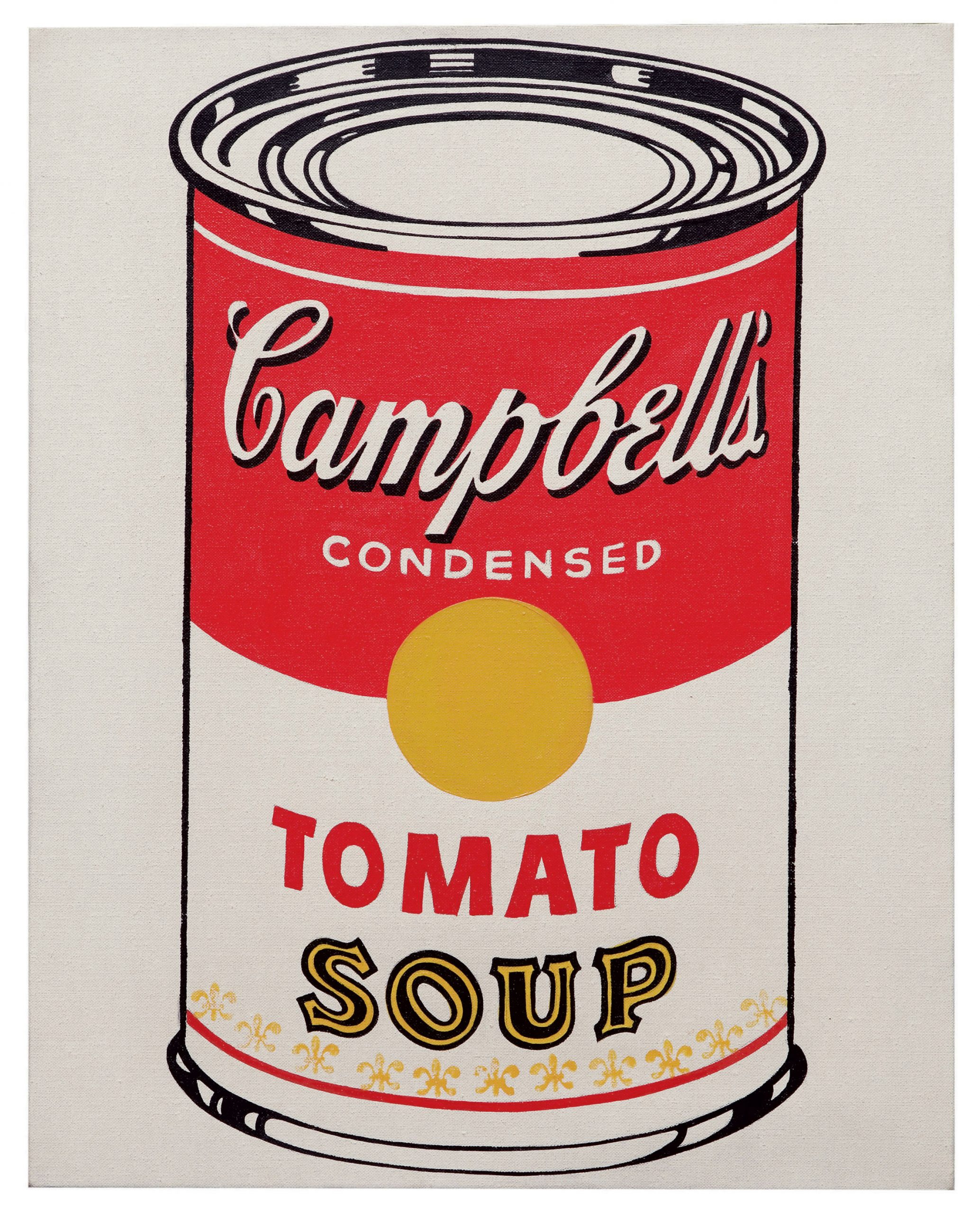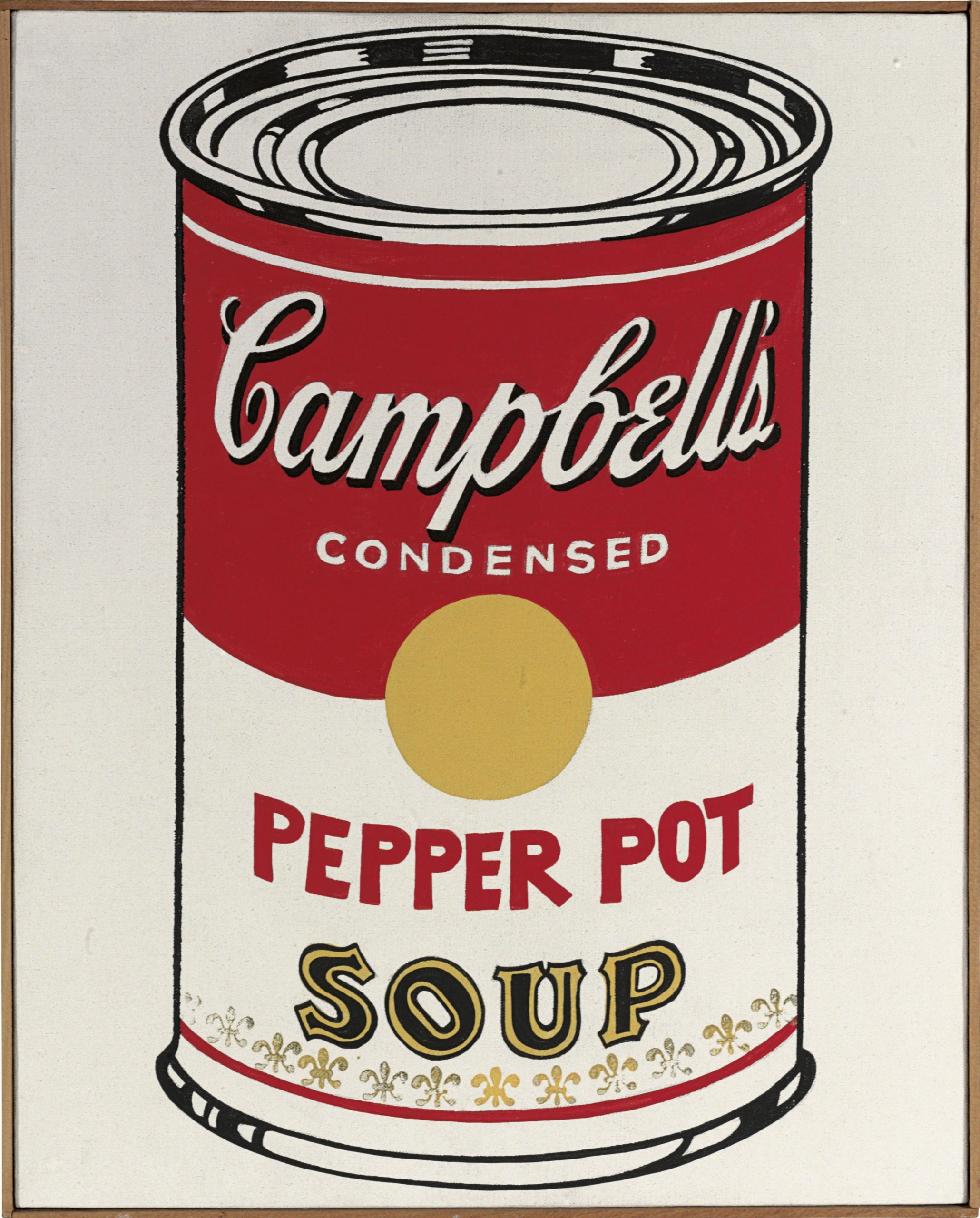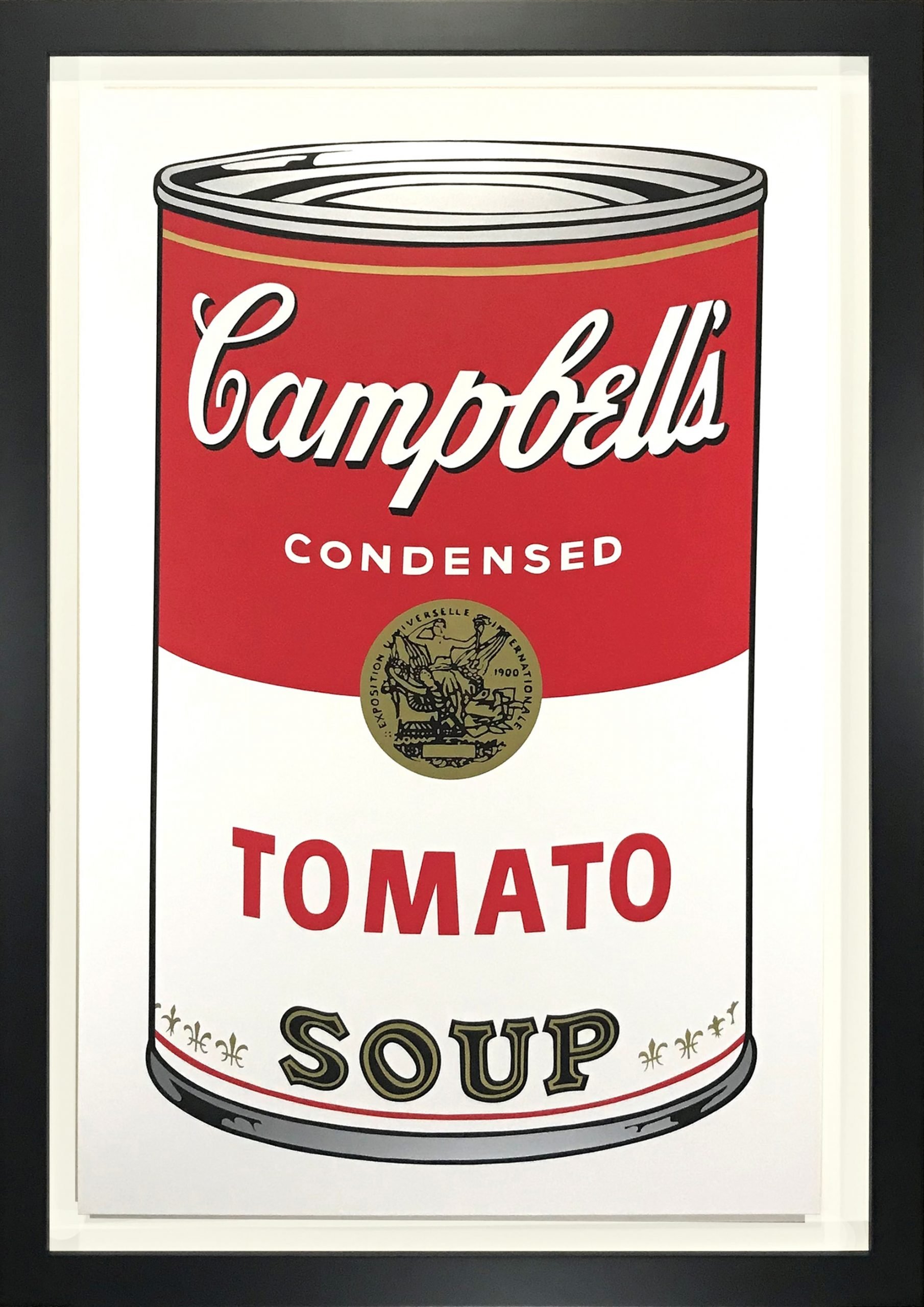Andy Warhol Was Fascinated With Consumerist Culture
From a young age Warhol was obsessed with consumerist culture, including magazine advertisements, celebrities and fashion. This enduring interest came to play out in his best-known works of art, most notably in his iconic, hand-painted Campbells Soup Cans, 1962. This work is one of many he made with images from commercial culture, celebrating the simple motifs and appealingly bright colors of advertising. Before painting his soup cans, Warhol painted the canned Del Monte Peach Halves his mother used to give him as a child. He later brought other American brands into his artworks, including Brillo and Coca-Cola. We can even read Warhols many celebrity portraits as a response to mass media, and the idea of a persons image as a commercial brand.
Why Did Andy Warhol Paint Soup Cans
Curated by TheCollector
Andy Warhol is the world-renowned poster boy of American Pop Art, who stunned the art world with his striking and instantly recognizable motifs. He was one of the first to take branding and imagery from popular, everyday culture and translate it into bold, confrontational works of art. And he proved that the worlds of design, advertising and art need not be so separate after all. One of Warhols most famous motifs is his Campbells Soup Cans, which he translated into artworks and clothing. But why the humble soup can? Lets look at Warhols life to understand more.
Campbells Soup Cans Helped To Launch Warhols Factory
As critics and public alike began warming to Warhols daring introduction of commercialism to the world of art, the artist was already thinking of new ways to make his work closer to the manufacturing methods of modern packaging and advertising.
As he famously claimed, I want to be a machine, and in a way he achieved this by his adoption of the silkscreen technique and the establishment of his Factory, a large studio where he could churn out hundreds of prints in a day.
Don’t Miss: Olive Garden Gluten Free Soup
Why Andy Warhol Was So Obsessed With Campbell’s Soup
One need not be a connoisseur of fine art to recognize Andy Warhol’s Campbell’s soup can paintings. In fact, that was kind of the whole point Warhol wanted to create art out of something as recognizable as the pantry staple you generally push out of the way when you’re on the hunt for more olive oil. To understand why, we have to talk a little more about Warhol himself, and the events that led up to his “soup-er” decision to go from paint cans to painting cans a decision that catapulted Warhol from general obscurity to pop art prince.
Warhol was born Andrew Warhola in Pittsburgh, Pennsylvania, in 1928, according to The Tate. Before Campbell’s cans put him on the pop art map, Warhol was a commercial artist living in New York, selling handdrawn pictures of shoes and illustrating advertisements for fashion magazines . He badly wanted to break into the fine arts scene that was blossoming around him, but as he watched friends and peers find success with paintings influenced by comic books and billboard ads, Warhol felt more jealous than inspired. In fact, it was skipping out on his pal’s art show in 1961 that left room for a dinner with art dealer Muriel Latow, the woman who allegedly gave Warhol the idea to paint Campbell’s soup cans.
Developing An Art Style

Whilst beginning his commercial work in the early 1960s, Warhol chose to spend time developing his own unique style. Initially beginning with canvas work in a comic strip style, Warhol learned how to silkscreen in 1961, and the medium to paint Campbells Soup was born.
At this time, Warhol also developed his style of simple and repeated work that, at the time, opposed the soft edges and almost sensual style of popular art and still life. His realistic interpretations of regularly accessible food and cultural items made his art intriguing to people who painted for fantasy, or in the comic strip style.
Don’t Miss: Instant Pot Potato Soup Frozen Hash Browns
A Bank Of America Masterpiece Moment
Hassams incorporates French Impressionist techniques into a fully American urban scene, while foreshadowing the social progress to come
Smarthistory is a nonprofit organizationAt Smarthistory we believe art has the power to transform lives and to build understanding across cultures. We believe that the brilliant histories of art belong to everyone, no matter their background.Smarthistorys free, award-winning digital content unlocks the expertise of hundreds of leading scholars, making the history of art accessible and engaging to more people, in more places, than any other provider.
Whats The Story Behind Campbells Soup Cans
One of the first exhibitions to launch Warhols rise to fame in the art world was held in July 1962 at the Ferus Gallery in Los Angeles. The show presented 32 canvases measuring 51x41cm, each one depicting a different flavour of Campbells Soup, lined up in a single row on a ledge, wrapping around the gallery. Campbells Soup Cans were some of Warhols first works based on common consumer goods and introduced many of the themes and techniques that would continue in his works. These 32 canvases give the illusion of being mass-produced, like printed advertisements, however each was hand painted, indeed the only variation between each canvas is the flavour of the soup. This contrast between the subject and its representation embodies the tension between high and low art, advertising and painting, that was at the crux of Warhols work and pop art. With Campbells Soup Cans, Warhol took a commonplace everyday item and elevated it to an iconic symbol of Pop Art.
Campbells Soup Cans also mark a transitional moment for Warhol, as he moved from painting to his famous photographic-silkscreen printing process. Adopting this traditionally commercial technique, he thus linked his work even closer to advertising, claiming: I dont think art should be only for the select few, I think it should be for the mass of the American people. Indeed, he would later return to the Campbells Soup Cans and reproduce the motif with this technique.
Recommended Reading: Pillsbury Slow Cooker Chicken Pot Pie
Life Imitating Art Imitating Life
Like everything great about art and popular culture and popular art culture there are no simple answers. Accounts of the evening vary, but according to Smithsonian Magazine, Andy Warhol begged his friend Latow for an idea that could rival his friend’s pop art pieces, while being different enough to make him stand out. The shrewd Latow insisted that Warhol fork over $50 for her suggestion, and when he did, her response was as simple as tomato soup: paint something everyone recognizes. Pop art was just getting its legs and gaining ground in the early 1960s, as the public seemed to want a change from the abstract and expressionist styles of the previous decade. Vanity Fair says Latow told Warhol he should stick with the basics and appeal to the materialistic culture of the day then she gave Warhol two ideas for the price of $50, suggesting he paint money or Campbell’s soup.
Campbells Soup A Real Brand Behind The Art
Warhol claimed to eat a lot of Campbells Soup one for lunch every day for 20 years, to be precise. He had no fear of repetition and even said it himself, the same thing over and over again. So, was it a publicity stunt for the brand? Consumerism was at the heart of American society, but bringing it into galleries was still unthinkable.
Warhol, however, was dead set on bringing mass consumerism and real life into the field of art. To reflect the world around him, he used advertising images, photos of celebrities, and comics. Pop Art acknowledges reality, as did the Campbells Soup brand itself, with the slogan, Made for real, real life.
You May Like: Campbells Sloppy Joe
Please Check Your Inbox To Activate Your Subscription
The Campbells Soup Can was an affordable and storable food option when rationing and austerity still blighted the lives of so many. Looking back, it is a fitting emblem of the post-war times in which Warhol was living. When Warhol created his cheap, wearable paper souper dresses featuring the same Campbells motif, he further broke down divides between art and life. Making his dresses cheaply from affordable materials meant just about anyone could buy a Warhol dress for themselves.
Warhol was attracted to the bold, striking simplicity of the Campbells Soup Can design, with its stark red and white colorways. He also enjoyed including text in his works of art, and reproducing advertisements allowed him room to experiment with this arena. In some ways the ornate, curled lettering of the Campbells logo can be compared with Warhols earlier illustration work, such as his shoe illustrations with hand-written areas of text in a similar cursive, slanted style.
What Was The Reception To Warhols Campbells Soup Cans
While Blum and Warhol had high hopes for the show it was not the initial success they had dreamed of. Many critics seized the opportunity to point fun at the idea and its admirers with one stating This young artist is either a soft-headed fool or a hard-headed charlatan, while a cartoon ran in the Los Angeles Times showing one art lover saying to the other: Frankly, the cream of asparagus does nothing for me, but the terrifying intensity of the chicken noodle gives me a real Zen feeling.
Meanwhile a rival gallerist decided to show up Warhol and Blum by displaying a selection of tins of Campbells Soup in his window accompanied by a sign that read, Do Not Be Misled. Get the Original. Our Low Price Two for 33 Cents. Little did they know this show would launch Warhols career and eventually turn him into a household name to rival Campbells.
You May Like: Cream Of Mushroom Soup Pot Roast
How Many Campbells Soup Cans Did Warhol Make
Warhol created a series of 32 painted cans, which were originally exhibited at Ferus Gallery in Los Angeles in 1962. The canvases depicted all the soups offered by the brand, from Vegetable Made with Beef Stock to Chicken N Dumplings and everything in between. Rather than being hung on the wall, the paintings were placed on shelves which the curator, Irving Blum had originally adopted as a solution for ensuring they were all level.
However the shelves quickly took on a different and very apt meaning, recalling the stacked displays used by supermarkets and reflecting the artists fascination with consumerism. Cans sit on shelves, Warhol later said about the installation. Why not?
Ever Heard Of Rainbow Soup

Five years after painting industrial Campbells Soup cans, Warhol personalized the tins with different colours. Reds, blues, greens, yellows and purples popped out from plain backgrounds! He created 19 brightly coloured posters using a more standard artistic approach. He had begun what would become his trademark polychrome series.
Also Check: Olive Garden Soup And Salad Hours
Warhol Had Campbells Soup For Lunch For 20 Years
Before he became famous for repetition in his artworks, Warhol was attracted to repetition in his personal life and appearance. By choosing to wear a daily uniform of a white wig, glasses and polo neck jumper Warhol ensured his look became as iconic as his artworks.
And it wasnt just his personal style that embraced repetition, even his eating habits mirrored his art. Speaking of his choice of Campbells Soup as a subject, the artist remarked, I used to drink it. I used to have the same lunch every day, for 20 years, I guess, the same thing over and over again.
Why Did Andy Warhol Paint Campbells Soup Cans
Andy Warhol was an American artist, film director and producer who lived between 1928 and 1987. He is best known as one of the icons of the pop art movement from the 60s. Much of his artwork expressed advertising and celebrity culture that thrived during the 1960s, along with highlighting basic products that represented life at the time. Some of his best-known work includes the silkscreen paintings of Campbells Soup Cans .
These consisted of 32 separate silkscreen canvases that formed one iconic painting one that many people connect our brand with even today.
Read Also: Potato Soup Frozen Hash Browns
Why Did The Paintings Become Such A Sensation
Left: Campbell’s ‘Souper’ dress, a paper fashion inspired by Andy Warhol’s Pop soup can paintings.
Once the public and the critics got over their shock, they warmed to Warhols soup cans. For one thing, they made art fun. How hard could it be to understand a painting when the original was probably on your kitchen shelf? Critics started to see the sly, ironic humor in Warhols portraits of Scotch Broth and Chicken Gumbo. And Blums decision to keep the paintings together heightened their impact.
The show at Ferus Gallery marked a turning point in Warhols career. After the Campbells Soup Cans, Warhol switched from painting to silkscreen printing, a process that produced more mechanical-looking results and allowed him to create multiple versions of a single work. His reputation continued to rise. By 1964, the asking price for a single soup can painting not in Blums set had shot up to $1,500, and New York socialites were wearing paper dresses in a soup can printcustom-made by Warhol himselfto gallery openings.
It didnt take long for Campbells Soups itself to join the fun. In the late 1960s, the company jumped on the then-popular fad for paper dresses, coming out with the Souper Dress, a kicky little number covered in Warhol-esque soup labels. Each dress had three gold bands at the bottom, so the wearer could snip her dress to the ideal length without cutting into the soup can pattern. The price: $1 and two Campbells Soup labels.
I Want To Be A Machine
Andy Warhol created his art in his studio, which he nicknamed The Factory, and saw himself as a machine. To make Campbells Soup Cans, he used serigraphy, a technique borrowed from the advertising world. The process involved recreating an industrial motif and repeating it in successive patterns.
Warhol was a real perfectionist and left nothing to chance! Every detail was vital, especially for this artwork. From afar, for example, they appear to be 32 identical cans. In reality, however, he has given each can a different flavour, from beef, to black bean, chicken noodle and onion. Suddenly, Campbells Soup had become more than just tomato soup Warhol had brought it flavour.
Read Also: Chicken Soup Shark Tank
Why Did Andy Warhol Paint Campbell Soup Cans
Known to be one of his most iconic work of all time, alongside his Marilyn Monroe portrait, the 32 Campbells Soup Cans from 1962 is still available to see by museum visitors today at the MoMA in New York. It was a personal favourite of Warhols, and something he enjoyed painting. He was quoted in an interview years after painting them as saying I should have just done the Campbells Soups and kept on doing them because everybody only does one painting anyway.
Many stories say that Warhols choice to paint soup cans reflected on his own devotion to Campbells soup as a customer. The most accepted story on the subject is that Warhol was having a conversation with a friend who encouraged him to paint something that you see every day, something that everyone would recognise. Campbells Soup was suggested as the appropriate brand an iconic American product that was readily found in cupboards across the country.
What Were The First Flavours Of Campbells Soup Cans
Tomato was one of the first flavours made by Campbells and it soon became a best-selling product. For Warhol this flavour and its iconic red colour encapsulated the nostalgia and mundanity associated with the soup brand and he chose it as a starting point for his paintings.
By 1969 the soup cans had become so synonymous with Pop Art and its chief proponent that legendary art director George Lois decided to put Warhol on the cover of the May issue of Esquire magazine, drowning in a tin of Campbells tomato soup.
Don’t Miss: Campbells Chicken And Rice Casserole With Broccoli
The Real Reason Andy Warhol Hated Campbell’s Soup
We may receive a commission on purchases made from links.
On July 9, 1962, a little-known artist by the name of Andy Warhol had his first solo art opening. The show was at the Ferus Gallery in Los Angeles, and it featured paintings that drew both marvel and ridicule Campbell’s soup cans. Each of the 32 paintings in the collection captured a single can of the company’s 32 varieties, from Asparagus to Scotch Broth.
For Warhol, it was a breakthrough. The 33-year-old had spent the better part of the last decade working as a commercial artist, drawing shoes for fashion houses and magazines as well as working in advertising for clients such as Dior and Tiffany & Co. Although Warhol had shown one-off pieces of art at galleries in New York, having a solo show on the opposite side of the country meant that he had made it. He was determined to leave his commercial art career behind to become a “real” artist, whose work would be celebrated by museums and critics.
Criticism To Campbell’s Soup Cans

Warhol’s exhibition in Los Angeles is strongly criticized. Collectors and those who want to invest in art are not convinced by the Campbell screenprints.
Warhol did nothing more than choose a commercial product, create a screenprint and reproduce it in series. Warhol’s soups, however, continued to be produced by the artist.
Read Also: Cheesecake Factory Cream Of Mushroom Soup Recipe
